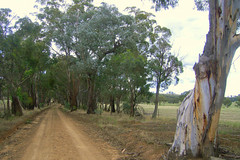 |
| White Box-Yellow Box-Blakely's Red Gum Grassy Woodland and Derived Native Grassland Ecological Community (Photo credit: Australian Network for Plant Conservation) |
Australia could lead the world in combating climate change. Wouldn’t you like to believe this was true?
Actually though, Australia has a world-beating model to deal with climate change.
But I’m not talking about energy efficiency programs. I’m not even talking about taxes or an emissions trading scheme. I’m talking about the land.
Climate abatement opportunities from the land are second only to abatement from the energy sector. What we might call the ecosystem sector could provide one third of the entire emissions reductions in Australia.
Here are just some examples of how: avoiding land clearing, changing grazing practises across the savannas, growing trees in salted soils, and managing crops by, say, reducing fertiliser use on sugar cane, and managing rice with less irrigation water.
These are opportunities reasonably well known in that they have methods to measure changes.
But there are large emerging opportunities, including growing mangroves as sea levels rise and sequestering carbon through wetland restoration so the sediment doesn’t flow into the Great Barrier Reef.
Ecosystems are the ultimate objective of the United Nations Framework Convention on Climate Change, where they are front and centre.
To avoid dangerous climate change, the convention says, the world needs to stabilise greenhouse gas concentrations within a timeframe that allows ecosystems to adapt naturally.
Fundamentally this is about how land is managed. Land management is central to our existence; a fact we seem to forget. It is our air and nourishment, our fresh water and shelter. It heals us. And the biodiversity that underpins it all is the context in which we operate.
The thing with climate change is that, worldwide, its impacts are regionally specific. The problems of the Great Barrier Reef are the problems of land management in its river catchments.
These are not the same impacts as those of the salt encrusted catchments running into the Murray Darling, nor the problems of the volatile and feral savanna catchments of the north, or the left-over forests in the catchments of the southeast.
The solutions, too, are regionally specific; which seems obvious. But it is a fact that only in Australia do we have a well developed framework that recognises this. It’s called, regional natural resource management a prosaic term that unfortunately works well at obscuring its great potential.
The regions are based sensibly on Australia’s bioregions, areas with similar ecological characteristics. Funding and grants are distributed to regional bodies which encompass a swathe of organisations, working together, and then on to innumerable projects on the ground.
Importantly, under this framework, the priorities are determined by those at the front line of managing the land’s wicked problems.
Almost incidentally this framework is a good foundation for combating climate change. Landholders could be paid for the ecosystem services they provide.
It’s a simple idea, but the effects could be huge. A pilot study in the Wet Tropics of Queensland, one of the smallest regions in Australia, found the potential carbon dioxide abatement was 1.8 million tons per year.
The pilot study (which incidentally was short-listed for the 2009 Eureka Science Prizes) showed this could be achieved by avoiding deforestation and logging, and reducing nitrogen fertiliser use on sugar cane - the main crop in the region.
It didn’t include reforestation or sustainable grazing, so the estimated carbon abatement is conservative.
If that’s what a small region can do, imagine what the rest of Australia could achieve. There are 55 other regions, and many have much greater potential for carbon abatement than the Wet Tropics.
Theoretically at least it may well be possible to meet Australia’s 5% emissions target by looking after our land and water alone.
But you would need a carbon price that pays landholders for their ecosystem services. The Carbon Farming Initiative is a good framework if it could be streamlined to allow for regional carbon pooling.
Credits generated could ideally be traded within emissions trading schemes, like the one we currently have, or sold to the government under direct action if this action guaranteed an allocation to land management.
The Australian Bureau of Statistics suggests that ecosystems services of our terrestrial ecosystems are worth up to A$325 billion per year. There is a lot riding on this: you don’t just buy emissions, you buy resilient landscapes.
Penny van Oosterzee occasionally consults to regional NRM groups.
This article was originally published at The Conversation. Read the original article.

No comments:
Post a Comment